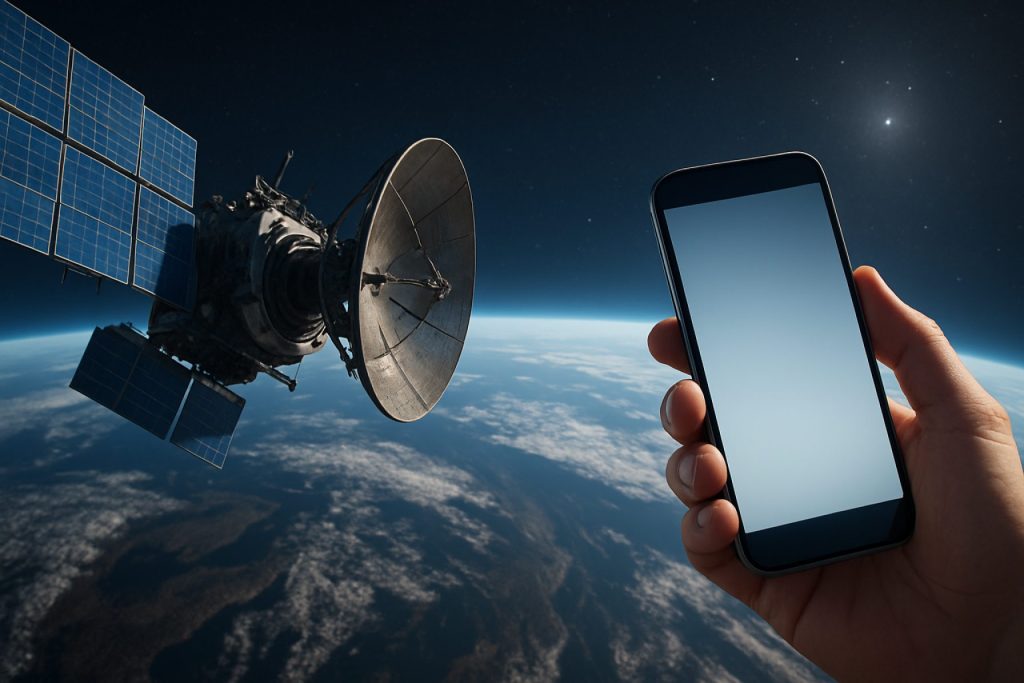
From Anywhere Connectivity to Everywhere Danger: Why Space-Based Mobile Networks Face a Cybersecurity Reckoning in 2025
Direct-to-cell satellites promise universal smartphone internet—if cyber risks don’t ground their potential. Discover the threats and solutions.
- 1.5B+ people will gain mobile internet from direct-to-cell satellites by 2027 (GSMA projection).
- Satellites: 6,000+ new D2C-capable satellites slated for launch by 2026.
- Seconds: An unpatched satellite can be attacked in under 60 seconds after going live.
- $30B global market size for space-based mobile broadband by 2030.
Imagine sending a text, checking email, or making a video call from the middle of the ocean or a mountain peak — no cell tower required. That’s not sci-fi anymore. Thanks to direct-to-cell (D2C) satellite communication, unmodified smartphones could soon connect straight to orbiting satellites, dissolving the last digital frontiers on Earth.
Championed by innovators like AST SpaceMobile, Lynk Global, and SpaceX’s Starlink, this technology is igniting a revolution in connectivity. But as satellite signals light up the globe, a new kind of cyber danger shadows every byte.
What Is Direct-to-Cell (D2C) Technology—and What’s at Stake?
Traditional coverage chains users to ground infrastructure: cell towers, fiber networks, data centers. D2C breaks free. In this model, satellites act as flying cell towers, beaming signals directly to ordinary phones—no special gear or ugly towers needed.
The advantages are massive:
– Seamless coverage in disaster zones and underserved areas
– Resilient networks for emergency services and businesses
– Access for millions left behind in the digital divide
But universal connectivity brings universal risk. As the world races to deploy mega-constellations of low Earth orbit (LEO) satellites, each system becomes a high-value target and a vast attack surface for hackers, criminal syndicates, and even hostile states.
What Makes D2C Networks So Vulnerable?
Unlike cell towers, satellites broadcast over vast distances, making physical proximity irrelevant for attackers. Here’s what sets D2C security challenges apart:
– Global exposure: Hackers can strike from anywhere—no more fence-hopping or server-room break-ins.
– Radio hacking: Jamming devices and spoofing tools are inexpensive and can disrupt entire regions.
– Targeted attacks: Nation-states or criminal groups could disable learning in remote communities or silence emergency services during crises.
If a single attack brings down a D2C network, the results could be catastrophic: cutoffs for first responders, students, or businesses—a crisis with ripple effects through economies and societies.
Common Attack Methods Threatening Satellite-Phone Networks
1. Signal Jamming & Spoofing: Hackers can overwhelm satellite signals or masquerade as legitimate channels—hijacking or blocking data at scale.
2. TT&C System Breaches: Hacked Telemetry, Tracking & Control (TT&C) systems can let attackers steer, disable, or destroy satellites.
3. Man-in-the-Middle (MitM): Weak encryption can let snoops intercept data between users and ground control.
4. Physical Sabotage: Think anti-satellite weapons, lasers, or even hazardous space debris—space is a real battlefield.
5. Ground Station Infiltration: On Earth, ground stations often run on vulnerable cloud platforms and are prime targets for phishing, ransomware, and configuration errors.
6. Tainted Supply Chains: A compromised microchip or firmware update can inject silent vulnerabilities.
7. Human Error: Untrained or careless staff, poor password practices, or malicious insiders can defeat even the strongest defenses.
Learn more about space threats at NASA and innovations at Starlink.
How Can Operators and Regulators Protect D2C Networks in 2025?
Future-proofing space networks means planning for threats nobody’s even imagined. Here’s how the industry can fight back:
1. Build an International Cybersecurity Council
Establish a UN-led council (like the International Civil Aviation Organization for space) to unite major players—governments, private companies, and regulators. Share incident data, set unified standards, and coordinate threat response. The UNOOSA could play a key role.
2. Create Defense-in-Depth Systems
Layered security—from AI-driven threat detection to shifting system configurations—will help identify and contain attacks early. Redundant ground stations and strict network segmentation can limit damage.
3. Deploy Advanced Encryption—Now
Modernize cryptographic protections. Prevention must anticipate the quantum threat era and prioritize zero-trust approaches—even for tiny, power-hungry satellites.
4. Harden Ground Infrastructure
Encrypt control-channel traffic. Deter tampering with phased-array antennas and biometric access controls. Simulate attacks to find cracks before criminals do.
5. Train and Audit Your Workforce
Train all mission operators to international standards like NIST or ISO/IEC 27001. Regular “fire drills” prepare teams for live attacks and raise awareness of phishing or insider threats.
6. Collaborate with Insurers and Regulators
Reward strong security by offering lower insurance premiums or fast-tracked regulatory approvals to operators with excellent cyber hygiene.
7. Invest in Continuous Security Research
Support industry, government, and academic research into emerging threats and new protections, from software-defined networking to verified firmware.
8. Share Threat Intel—Together
Develop a space-sector incident database, modeled after aviation safety systems. Anonymized reports can reveal new attack trends—and help everyone avoid repeated blunders.
Your Top D2C Security Questions Answered
Q: Are ordinary smartphones at risk with D2C satellites?
A: Any unmodified smartphone connecting directly to satellites could be vulnerable to jamming, spoofing, or interception—no specialized hacking tools required.
Q: What if a satellite is hacked?
A: Hackers could disrupt signals, re-route the satellite, or even render it useless—potentially disabling critical communications far below.
Q: How soon will D2C coverage go live?
A: Commercial launches are already happening. AST SpaceMobile and Lynk Global are in trials, and Starlink’s network is expanding rapidly in 2025.
How-To: Strengthen D2C Network Security
– Adopt end-to-end encryption for all data and control traffic.
– Run regular penetration testing and red-team exercises on satellites and ground stations.
– Segment D2C network traffic from other systems to contain breaches.
– Educate every engineer and operator on phishing and social engineering threats.
– Insist on secure firmware updates and robust supply chain controls.
– Create contingency plans for rapid incident response—across borders.
Act Now: Secure Space, Secure Earth
The next digital revolution is hovering overhead—will your systems be ready the moment satellites connect your customers? Take action today before the sky becomes the new cyber warzone.
Stay Secure Checklist:
- Establish international cybersecurity protocols
- Embed advanced, post-quantum encryption
- Train staff with regular cyber drills
- Continuously monitor for anomalies and incidents
- Invest in new R&D and collaborate across borders
- Document and share incident reports anonymously
- Work with insurers and regulators on compliance incentives
For more on the future of connectivity, explore GSMA and global tech news at CNN.
The digital sky belongs to us all—let’s make sure it’s secure.



